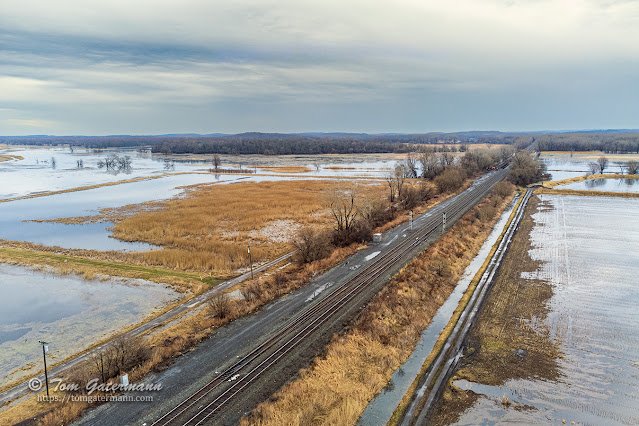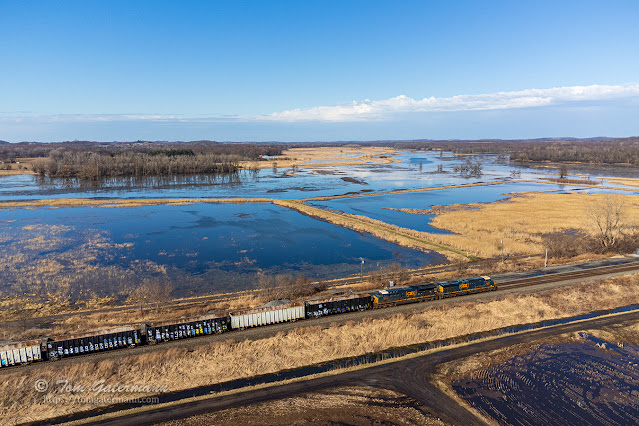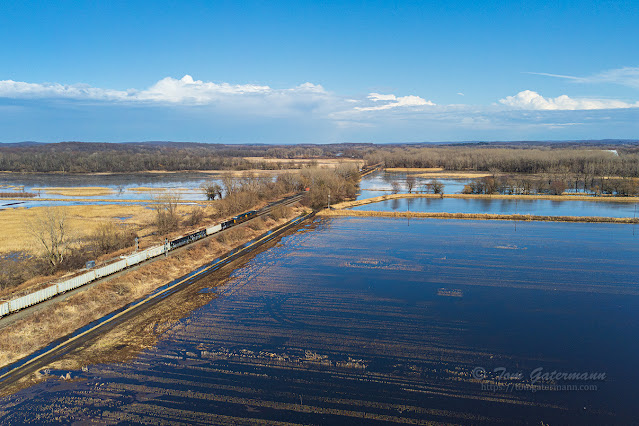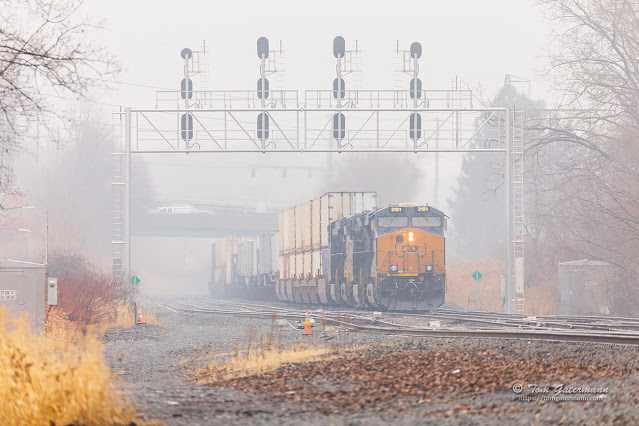
This past Saturday, I went to Savannah, New York, to check out control point (CP) 320 on CSX's Rochester Subdivision. The location is intriguing because the control point is on the southern edge of the Northern Montezuma Wildlife Management Area (NMWA) along the Seneca River and Crusoe Creek. Because of the spring thaw and lots of rain, the Seneca River and Crusoe Creek are flooding. I hoped the landscape would make an interesting backdrop.
CP320 of the Rochester Subdivision
Control Point (CP) 320 sits southeast of the confluence of the Seneca River and Crusoe Creek. It is to the west of the Seneca River and south of Crusoe Creek, along Railroad Road in the Town of Savannah, New York. CP320 is at milepost (MP) QC 320.5 of CSX's Rochester Subdivision (RS). Going east from CP320, the Rochester Subdivision first crosses over the original Seneca River channel on the
double-track Montezuma Trestle, a deck plate girder bridge. To the east of the trestle the line crosses over the Erie Canal channel on a thru truss style bridge.
 |
| Looking slightly northeast from CP320 toward the confluence of the Seneca River and Crusoe Creek. |
CP320 is at the eastern end of a 13,400 feet siding (per CSX's 2004 Albany Division Timetable) that diverges from Track 1 of the Rochester Subdivision. CP323 is at the western end. The Subdivision has two main tracks, with Track 2 being the southernmost track. CP320 has one crossing over track between Track 1 and Track 2. The westbound control point signals sit approximately 1,200 feet west of the Seneca River.
Manifest train Q634-18 at CP320
Shortly after arriving at CP320, the skies cleared up, and without the clouds, the sun's rays made an unfiltered appearance on the landscape. I heard a locomotive horn to the west of my location and knew from the scanner that manifest train Q634-18, would be the next train. However, I misjudged its arrival time. I assumed that because the horn was so loud that the train must be closer to CP320. It turned out that it was almost fifteen to twenty minutes away. Apparently, sound travels really well to the west of Savannah, New York.
 |
| CSXT 3072 and CSXT 3373 lead Q634-18 eastbound through CP320. The confluence of Crusoe Creek and the Seneca River are in the background. |
The 2004 timetable for this line states the tracks over the trestle have a 40MPH speed limit, but Q634-18 was going slower than that. With its empty trash/debris hoppers Q634-18 rumbled its way east through the control point. In the photograph above, the locomotives are between the eastbound and westbound control point signals. In the background is the overflowing confluence of the Seneca River and Crusoe Creek.
 |
| Q634-18 is eastbound, approaching the trestle over the Seneca River and Hog Island. |
Once the Q634-18 crosses the trestle over the Seneca River, it'll be on Hog Island for a short time before crossing over the Erie Canal bridge into Montezuma, New York. Hog Island, and the larger Howland Island north of it, were created when the channel for the Erie Canal was dug, bypassing the Seneca River's less direct path through the area.
 |
Q634-18 stretched well close to mile and a half to the west of CP320. Crusoe
Creek is in the background following a similar curvature as the train tracks.
|
Amtrak Empire Serice train P281
A short while later I heard train P281 calling out signals as it made its way west on the Rochester Subdivision. Since the weather seemed to be cooperating, I waited around to catch P281. P281, led by AMTK 716, seemed to be doing close to track speed as it came off the Seneca River trestle and through CP320.
 |
| AMTK 716 leads P281 west under the cantilever signal bridge with the eastbound block signals at CP320. |
That's all folks
 |
| Me, standing on Railroad Road, waving to the camera. |
After P281 rolled by, the clouds started to gather to the west again, bringing with them more rain. I decided that I had a good outing at CP320, and it was time to head home.
 |
Clouds moved in from the west, and a short while later
brought more rain with them to an already flooded field. |
Photographs taken on March 19, 2022, at the Town of Savannah, New York.












Great images! Wish we could have some of your water. We are so low right now and we have been extremely windy making it even worse. Sigh
ReplyDeleteThanks a lot, Shelly! I wish I could send some of the water your way. We have plenty up here. Between the snow melting and the spring rains the rivers have been very high here.
Delete